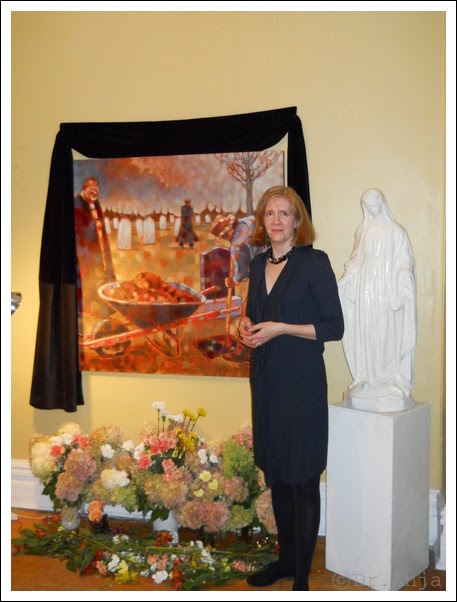 |
The Canadian War Museum, Ottawa
|
“Transformations. A.Y. Jackson and Otto Dix – Art shaped by War” is the current special exhibition at the Canadian War Museum, Ottawa. I finally had a chance to visit that excellent show.
The exhibition sheds light on the artistic development of Canadian painter
A.Y. Jackson (1882–1974), and German painter
Otto Dix (1891-1969). These important 20th century artists are somewhat comparable, since both witnessed the First World War as soldiers. And the experiences they made had later a huge influence on their art. The War Museum's focus lies in particular on their landscapes, even though Dix is rather known for his critical and provoking depiction of the Weimar Society and the 1st World War, and turned to landscapes only later in life. Jackson instead is widely known for his Canadian landscapes.
The exhibition shows the parallel development of Jackson and Dix in five sections: Early Years (1882-1914), First World War (1914-1918), Post-War (1919-1932), Nazi Germany and the Second World War (1933-1945), and Later Years (1946-1974). To me it was very interesting to see how Dix' early landscapes were influence by Post-Impressionism (e.g. Van Gogh) and the Romantic tradition, in particular Caspar David Friedrich. Spending a couple of years in Dresden myself, I can imagine how Dix, who did grow up close by, was influence by that tradition since it is visible everywhere (very good collection at the Staatliche Kunstsammlungen Dresden BTW). But Dix was also influenced by Friedrich Nietzsche's writings, and Futurist and Apocalyptic Art what the exhibition demonstrates. That's compared to Jackson on the other side of the room (very good set-up for an exhibition to demonstrate the similarities of the two artists, in which the exhibition rooms are divided with Jackson on the right, and Dix on the left side), shedding light on Jackson's travels to Europe and his interest in the Canadian landscape after his return 1912. The exhibition also makes clear what impact his European studies had on his later landscape paintings.
Main focus of the exhibition is of course the enrolment of both artists in the First World War as soldiers and how they became witnesses of destruction and atrocities. Both created landscape art during and after the war which reflects their experiences of the conflict. Dix and Jackson were both soldiers, and Jackson, after wounded in 1916, became an official war artist in 1917.
Both express brutal destructiveness of the war in their landscapes, but do that very, very differently: Dix showed the brutal reality with gruel paintings as well as drawings of death, mutilated and rotting corpses, while Jackson shows the destructiveness in an indirect way by painting shattered trees in an rather Impressionist style. His landscapes were still beautiful, even though they show battlefields of the First World War! Dix' intentions were therefore different from Jackson's – even if his landscapes play an important compositional role in his major works like “The War” (1932), the depiction of death and atrocities is the main focus of his post-war works. His paintings and prints of German soldiers as victims led to under the Nazis to the defamation of his works as “degenerated” art, and forced Dix to an “inner exile” after the Nazis had him sacked from his post as an art teacher at the Dresden Academy of Art.
On the other hand, in the Canadian part of the exhibition, we see how Jackson was one leading founder of the Group of Seven in 1920, and how his landscapes were strongly influenced by his experiences in the First World War. The exhibition demonstrates why his landscape art is widely accepted as an expression of Canadian Identity. It's a fascinating show about two entirely different artists whose works and lives were shaped by their experiences of war.

Furthermore, I had a chance to visit at the other remarkable exhibition at the War Museum “Witness - Canadian Art of the First World War”. It shows how Canadians depicted their First World War experiences in art, both at home and overseas. One painting in particular stroked me: “The Sunken Road” by Frederick Varley (1919). While working as an artist for the Canadian War Records Department Varley witnessed combat on the front lines. He depicted what war was really like, in clearly showing destruction and cruelties, like corpses lying on a abandoned battlefield. I found that much more analogous to Dix' work than Jackson's which never shows the brutality of the war directly. But maybe that's one of the intentions of the “Transformations”-exhibition: How witnessing a war can impact Oeuvres and lives in totally different ways ...
Both exhibitions were extended until September 26th, 2014.
 |
| Canadian War Museum, Ottawa. Unfortunately, it's not allowed to take photos inside the exhibition. |
Facts:Transformations – A. Y. Jackson and Otto Dix
Canadian War Museum
April 10, 2014 - September 26, 2014 (extended!)
http://www.warmuseum.ca/transformations/










